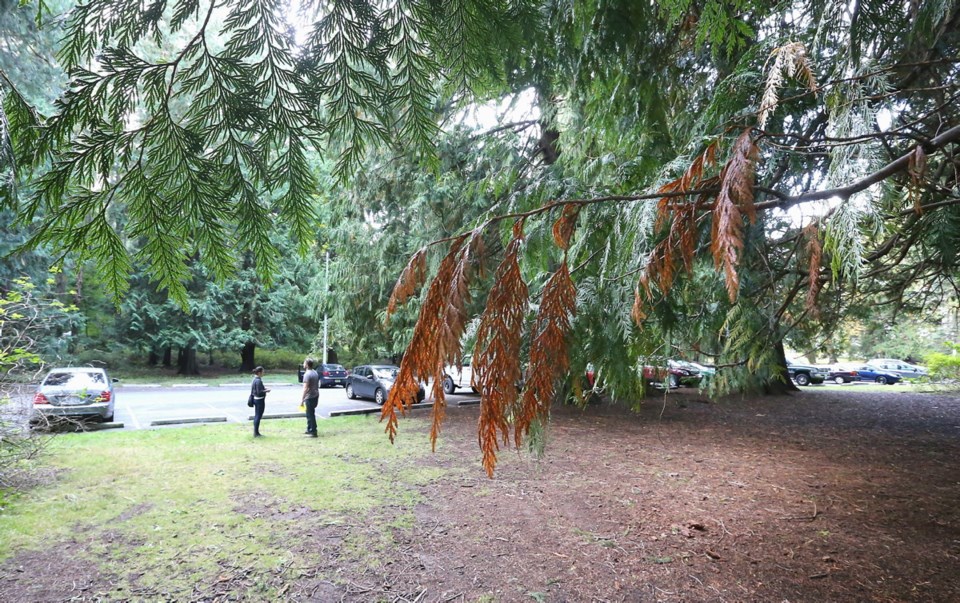Recent summers with drought-like conditions have damaged Vancouver Island trees, especially cedars.
“We are noticing clear, identifiable ‘flagging,’ ” said Andrew Burger, manager of park operations in Saanich. “That’s what we call it when you start seeing all the needles going brown.
“This year we’re noticing actual complete die-off of a lot of cedars in our parks, like Mount Doug and some of our bigger, forested parks.”
Dryness last winter also contributed to the die-off, he said.
Peter Constabel, a University of Victoria biology professor and director of the Centre for Forest Biology, called cedars the “canary in the coal mine” for drought damage.
“Cedar is the first one that we notice,” he said. “It’s the most sensitive, the most susceptible.”
Last year, experts pointed to the damaging effect of drought on western red cedar — B.C.’s official tree — and Parksville reported a “devastating loss” of cedar trees in its parks.
“We still see cedars [affected], especially driving up and down the Island Highway and just going up-Island a little bit,” Constabel said. “We see lots of them seem to be dying.”
Other trees also appear to be having a tough time, he said, including western hemlock.
“One of my colleagues said that some of the grand firs seem to be dying, as well, ” he said.
“That could perhaps be due to the cumulative effects of two seasons that were pretty hard on them.”
In Saanich, maintaining boulevard trees is becoming harder due to dry conditions, Burger said.
Young trees need to be watered more frequently and for longer periods.
“We have some trees we planted seven years ago that we see are still kind of stressed out under the drought, so we’re going back and rewatering them.”
A watering regime of three to five years was the previous norm.
Saanich has responded by adding new equipment, with a pair of new watering trucks, doubling the fleet. High-efficiency drip-irrigation systems for trees are also being installed.
Other jurisdictions have similar concerns about drought, Burger said, which has prompted discussion among municipalities about options for planting drought-resistant trees, including Persian ironwood trees and red oaks.
Garry oak and Arbutus are also highly drought-resistant, Constabel said.
Drought-damaged trees will not necessarily return to health in the winter with increased precipitation, he said.
“Some of their roots get damaged and one of the big concerns is cumulative stresses. They get weakened from one stress and then perhaps a pathogen can get in.”
That can make trees susceptible to problems such as root rot.
“It’s quite possible that after a really dry season, there isn’t really that much energy for the winter, or there’s less energy.”
Also linked to the recent drought was a die-back of salal, a common and hardy ground cover on the forest floor.
Constabel said the salal is believed to be suffering from a combination of drought and winter cold.
“It got nailed with a really cold spell in February and strong winds from the north,” he said. “So that affected a lot of the salal, even though I think it’s coming back.”
Constabel said dry conditions have also been linked to toppling trees and branches.
A few maples at the University of Victoria lost branches in the driest part of the summer, he said.
“Somehow, the wood gave way, so it was very surprising,” Constabel said.
“You’d think they’d contain less water and should be lighter.”
The drought also affected rivers such as the Koksilah River south of Duncan, where low water levels prompted a period of restricted water use. Pumps had to be used to get water from Cowichan Lake into the Cowichan River to keep it flowing after years of lack of precipitation.
Environment Canada meteorologist Bobby Sekhon said that from Aug. 3 to Sept. 2, there was less than 60 per cent of average precipitation on the south Island and less than 40 per cent of average precipitation on the east Island.



